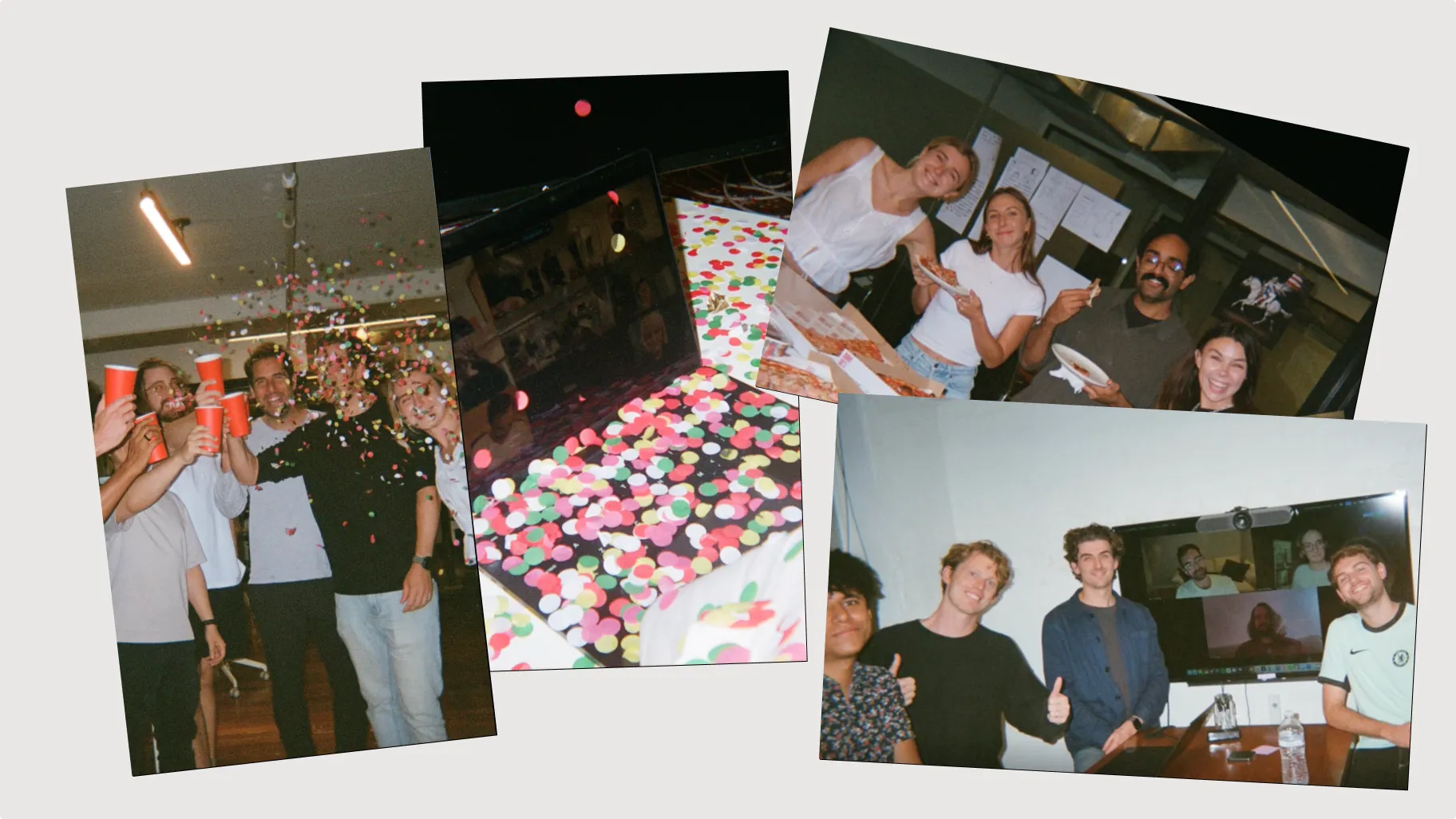From bottleneck to breakthrough
How Hatch eliminated customer feedback silos during their biggest product launch
Insights from

Hatch
A talent marketplace connecting employers with top-tier candidates.

Tom Mansfield
CRO

Isabella Codsi
Sales

Maria Coffey
Customer Success

About Hatch
Integrations used
Twine call bot
Record and identify key moments from your calls
Slack
Reports and clips delivered where your teams already work
Impact
Growing fast while staying connected to customers
Hatch operates as an AI-powered job marketplace, connecting Australia’s top employers with high-quality job seekers in an increasingly competitive market. As a fast-moving startup with distributed teams and an ambitious product roadmap, they needed to balance speed with staying closely connected to customer needs.
“We do a lot of very fast product work, and product work immediately impacts the customer side of the business,” explains Tom Mansfield, CRO.
But rapid growth brought a critical challenge: how to maintain tight feedback loops between customer-facing teams and product development without creating bottlenecks that would slow their momentum.
Scaling introduces the intelligence trap
Before implementing Twine, Hatch faced the classic scaling challenge where valuable customer insights became trapped in deep information repositories, especially during their recent platform update.
“We didn’t really have a real time conversation between go-to-market and product. It fell upon essentially the leadership team to transmute lots of real time product data into the revenue stream, and that created a bottleneck.”
— Tom Mansfield, CRO
This centralized approach meant only the highest-priority burning issues received attention, while smaller but collectively significant feedback points disappeared into the noise.
“It’s a bit shameful describing the ‘before’ process, because it was so reliant on me remembering to do things,” Isabella Codsi, Sales rep, reflects. “Someone might catch me right after I’d had a customer call, and we’d have a quick chat… but in the midst of doing all kinds of follow-ups, I would forget to connect the feedback loop back. Now I feel empowered knowing that nothing is falling through the cracks. Twine captures what I might miss.”
For Maria Coffey, Customer Success Manager, manual processes consumed valuable customer-facing time: “Taking detailed notes during calls meant I couldn’t be fully present with customers. Knowing Twine is capturing all of their insights, which are then shared instantly with our Product team, means I can spend the time with our users more efficiently.”
The transformation at a glance
| Area | Before Twine | After Twine |
|---|---|---|
| Feedback collection | Manual note-taking, memory-dependent | Auto-captured from every conversation |
| Decision timeline | Weeks to surface insights | Real-time intel to product team |
| Team alignment | Leadership bottleneck for real-time communication | Shared context across all teams |
| Product iterations | Monthly feedback cycles | Hotfixes deployed within days |
| Research overhead | Hours digging through repositories | 70%+ reduction in search time |
| Information quality | Subjective, filtered through individuals | Objective customer voice with video evidence |
Implementation and immediate impact
Hatch’s decision to implement Twine coincided with their complete platform relaunch—a critical period where feedback velocity could make or break customer satisfaction. “We were doing so much so quickly in the product world that it was incredibly hard to keep up with the actual on-the-ground customer feedback,” Tom explains.
Setup was refreshingly simple: one afternoon to connect Slack and calendars, with no workflow changes required. The team saw value from day one. “Having something that’s really easy to implement, low touch ongoing, and just sort of fluid was critical,” Tom notes.
The implementation created immediate and lasting changes across Hatch’s organization, turning their biggest operational challenge into a competitive advantage.
“The time spent in the business digging into legacy repositories to find inputs that inform product decisions has reduced by over 70%. We’ve completely eliminated the having to dig deep into documents process, which allows our product team to move faster.”
— Tom Mansfield, CRO
This efficiency gain proved especially valuable for their lean team: “Our organization having one PM… his time is incredibly sacred, so minimizing some amount of hours every week trying to do discovery on insights has knock-on effects.”
Creating shared context across teams
Isabella noticed an immediate cultural shift: “It’s just really useful that we’re all working from the same knowledge bank now. It’s as if the product team have had the conversations I’ve had, because they’ve seen a lot of it transpire in real time.”
This shared context accelerated decision-making: “When we then do more retroactive sessions, I’m able to reference a call and say ‘remember you saw that’? Whereas previously I’d have to start those stories from the beginning.”
Perhaps most importantly, Twine created a cultural shift in how feedback was perceived and acted upon. Tom observed: “It legitimizes feedback regardless of who’s on the call. People know when to look at Twine, that there’s interesting stuff there, therefore people listen to it.”
Measurable business outcomes
The impact on customer experience has been dramatic. Tom explains: “We’re able to really quickly figure out what the small paper cuts are and share them in real time, and then they get fed into the product and engineering workflow, which means we can get a lot more small wins, which make customers feel better.”
“The quantitative feedback Twine pulls has been a game changer in pinpointing what feature introduction will have the biggest impact for customers.”
— Maria Coffey, Customer Success
Maria points to their recommendation model as a concrete example: “Twine identified similar feedback from multiple users across different accounts. This helped to prioritise a fix in the roadmap and the refinement to the model was released within a couple of weeks from the first improvement suggestion.”
For Tom, Twine provided insight into conversations he couldn’t personally attend: “I’m in maybe 30% of sales calls… That means there are things happening in the sales calls that Adam and I aren’t in that we would ordinarily not really be exposed to.” This comprehensive view improved sales strategy: “The revenue team itself feels like we’re more aligned than ever on how our sales process is playing out.”
Cultural transformation and unexpected discoveries
Hatch discovered value beyond traditional B2B applications. Tom notes: “We’ve actually been using Twine on both sides of the marketplace. Not only for paying customers who have a specific commercial need, but we also use it in all of our job seeker discovery calls.” This broader application enabled rapid user experience improvements: “I’ve seen a lot of those hot fixes being deployed in much more real time than they would otherwise.”
Beyond operational improvements, Twine fostered a more customer-centric, data-driven culture across Hatch. Isabella particularly valued Twine’s objectivity:
“I’m trying to cut myself out as the middleman between the customer and the product team. It helps keep me accountable to not letting my own biases around what I think would be the most commercial feature color our roadmap.”
— Isabella Codsi, Sales
Isabella noted how Twine created a feedback-sharing culture: “This channel where we’re reposting Twine insights is now where we are inclined to just dump any kind of feedback we’re getting, even if it’s from emails and LinkedIn messages.” Maria found unexpected value in surfacing wins alongside issues: “Twine has not only helped with identifying areas of the product we could improve, but also the features customers are loving. It’s nice to share the positive feedback with the rest of the team!”
Looking ahead
As Hatch continues scaling, the foundation Twine provides becomes increasingly valuable. They’ve transformed from an organization where customer intelligence was bottlenecked through senior leadership to one where insights flow automatically to the right teams at the right time.
“We’ve transitioned from feeling like there was partially bottlenecked communication between the two sides of the org to a point where, without any effort, I feel like there is consistent and reliable feedback going from one to the other.”
— Tom Mansfield, CRO
For other fast-growing companies facing similar challenges, Isabella offers this insight: “The temptation would be to think that a small team doesn’t need something to facilitate communication. That would be a total misconception of the value here. I’ve found Twine so useful in scaling myself as a limited resource into the product team.”
Want to learn how Twine can help your startup make better decisions? Book a demo.
About Hatch
Integrations used
Twine call bot
Record and identify key moments from your calls
Slack
Reports and clips delivered where your teams already work
